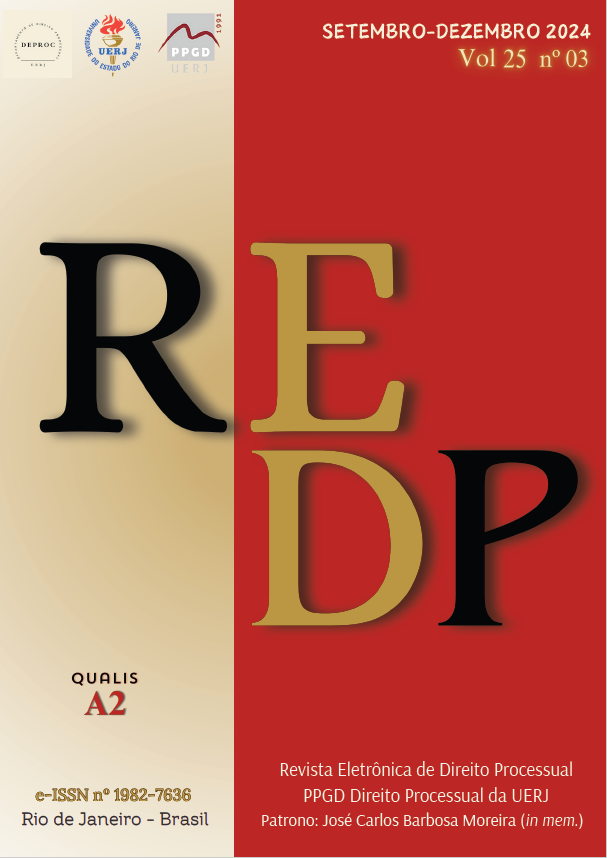A MEDIAÇÃO FAMILIAR NOS PROCESSOS JUDICIAIS DE REGULAÇÃO DAS RESPONSABILIDADES PARENTAIS: UMA VIA PARA A COPARENTALIDADE POSITIVA?
DOI:
https://doi.org/10.12957/redp.2024.86592Resumo
A mediação, enquanto meio de resolução alternativa de litígios, pode assumir um papel preponderante na mitigação de conflitos de natureza familiar. Nos processos judiciais de regulação do exercício das responsabilidades parentais, a possibilidade de intervenção dos serviços públicos ou privados de mediação é reconhecida na lei, como manifestação da preferência legislativa por soluções consensualizadas. Aquilo que se pretende é que ambas as partes busquem a solução que melhor se adeque ao superior interesse da criança, tendo em conta a sua concreta realidade familiar. Este estudo, além de dar a conhecer a possibilidade de intervenção da mediação familiar nos processos judiciais de regulação do exercício das responsabilidades parentais, pretende evidenciar a importância da mediação como instrumento eficaz na elaboração de acordos que promovam a corresponsabilização parental. Investigar como a mediação familiar pode influenciar a dinâmica da parentalidade, examinando a eficácia dos acordos estabelecidos durante o processo de regulação das responsabilidades parentais e as vantagens que resultam da sua adoção é o que nos propomos desenvolver. Conclui-se pela necessidade premente da criação de estratégias-chave que fomentem o acesso à mediação, sensibilizando os profissionais forenses para o seu impacto no sucesso do cumprimento do que houver sido acordado quanto aos termos por que se devem reger as responsabilidades parentais.
Downloads
Publicado
Como Citar
Edição
Seção
Licença
Copyright (c) 2024 Ana Raquel Magalhães Barbosa, Lurdes Varregoso Mesquita

Este trabalho está licenciado sob uma licença Creative Commons Attribution 4.0 International License.
Todos os artigos publicados na Revista Eletrônica de Direito Processual (REDP) (Departamento de Direito Processual, Universidade do Estado do Rio de Janeiro, Brasil) são licenciados por meio de uma Licença Creative Commons - Atribuição 4.0 Internacional (CC BY 4.0).
Os autores retêm os direitos autorais de seu artigo e concordam em licenciar seu trabalho com a licença CC BY 4.0, aceitando assim os termos e condições específicos desta licença disponíveis no seguinte website: https://creativecommons.org/licenses/by/4.0/legalcode.
- Os autores concedem à REDP o direito de primeira publicação, de se identificar como publicadora original do trabalho e concedem à revista uma licença de direitos não exclusivos para utilizar o trabalho das seguintes formas: Reproduzir, vender e distribuir cópias eletrônicas ou impressas do manuscrito como um todo, de partes específicas do manuscrito e de suas traduções para qualquer idioma;
- O uso do artigo por terceiros é livre, contanto que a integridade da publicação seja mantida e seus autores originais, periódico de primeira publicação e detalhes de citação sejam identificados.
Dentro dos termos da licença, os autores podem entrar em acordos contratuais adicionais separados para a distribuição não exclusiva da versão publicada do trabalho na revista.
Copyright and Licensing
All articles published in the Procedural Law Electronic Review (REDP) (Department of Procedural Law, State University of Rio de Janeiro, Brazil) are licensed under a Creative Commons License - Attribution 4.0 International (CC BY 4.0).
- Authors retain copyright to their article and agree to license their work under the CC BY 4.0 license, thereby accepting the specific terms and conditions of this license available at the following website: https://creativecommons.org/licenses/by/4.0/ legal code.
- Authors grant REDP the right of first publication, to identify itself as the original publisher of the work, and grant the journal a non-exclusive license to use the work in the following ways: Reproduce, sell and distribute electronic or printed copies of the manuscript as a whole, of specific parts of the manuscript and its translations into any language;
- Use of the article by third parties is free, as long as the integrity of the publication is maintained and its original authors, first publication journal, and citation details are identified.
Within the terms of the license, authors may enter into separate additional contractual agreements for the non-exclusive distribution of the published version of the work in the journal.




